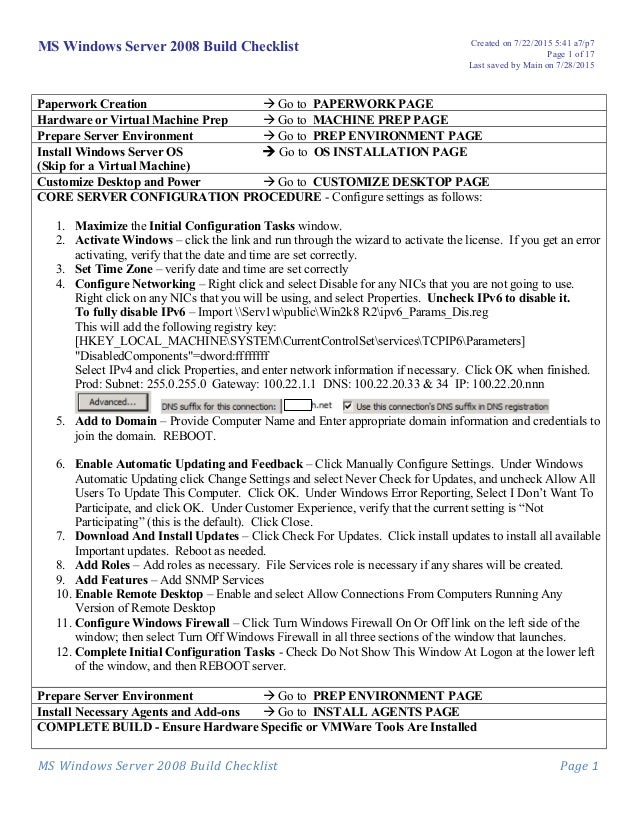Windows Server Build Checklist Template

Virtual Machine Virtual Template Windows Physical Server ESX Server. Documents Similar To Windows and ESX Server Build Document Checklist. Skip carousel. The following installation checklist is an example of a customer-generated installation. Windows Server 2016. Example Configuration Manager Installation.
Server Maintenance Checklist Servers are amazing things. They hum along 24/7, usually without issue, but like any machine they do require some maintenance.
Simple maintenance and monitoring can often prevent a server failure from turning into a server disaster. For example, I’ve had people call in a panic that there server has crashed. We begin to investigate to discover that their RAID failed last year, their backups stopped three months ago and their disk reached 100% capacity, corrupting their database. If you use our solutions, you don’t have to worry about these things. We monitor, review and maintain things 24/7, but ifyou are managing your own server, here are twelve items that should be part of your server maintenance checklist. Alert: Summer Special.
Just $199/mo for our server management services.. 12 Server Maintenance Tips 1. Verify your backups are working. Before making any changes to your production system, be sure that your backups are working. You may even want to run some test recoveries if you are going to delete critical data. While focused on backups, you may want to make sure you have selected the right. Check disk usage.
Don’t use your production system as an archival system. Delete old logs, emails, and software versions no longer used. Keeping your system free of old software limits security issues. A smaller data footprint means faster recovery. If your usage is exceeding 90% of disk capacity, either reduce usage or add more storage. If your partition reaches 100%, your server may stop responding, database tables can corrupt and data may be lost. Monitor RAID Alarms.
All production servers should use RAID. More importantly, you should be monitoring your RAID status. In our decade plus in business, we have worked on countless systems where the RAID failed. As a result, a single disk failure caused a complete system failure. At rackAID, we either use providers that monitor our RAID for us or we have setup direct RAID monitoring. Roughly I estimate that RAID fails in about 1% of servers per year.
One percent may seem small, but a complete server failure can turn a simple drive replacement into a multi-hour disaster recovery scenario. Update Your OS. Updates for Linux systems are release frequently.
Staying on top of these updates can be challenging. This is why we use automated patch management tools and have monitoring in place to alert us when a system is out of date.
If you are updating your server manually (or not at all), you may miss important security updates. Hackers often scan for vulnerably systems within hours of a issue being disclosed.
So rapid response is key. If you cannot automate your updates, then create a schedule to update your system. I recommend weekly at a minimum for current versions and perhaps monthly for older OS versions. I would also monitor release notices from your distribution so you are aware of any major security threats and can respond quickly. Update your Control Panel. Bmw Navigation Firmware Update V32 Download Games. If you are using a hosting or server control panel, be sure to update it as well.
Sometimes this means updating not only the control panel itself, but also software it controls. For example, with WHM/cPanel, you must manually update PHP versions to fix known issues. Simply updating the control panel does not also update the underlying Apache and PHP versions used by your OS. Check application updates. Web applications account for more than 95% of all security breaches we investigate. Be sure to update your web applications, especially popular programs like WordPress.